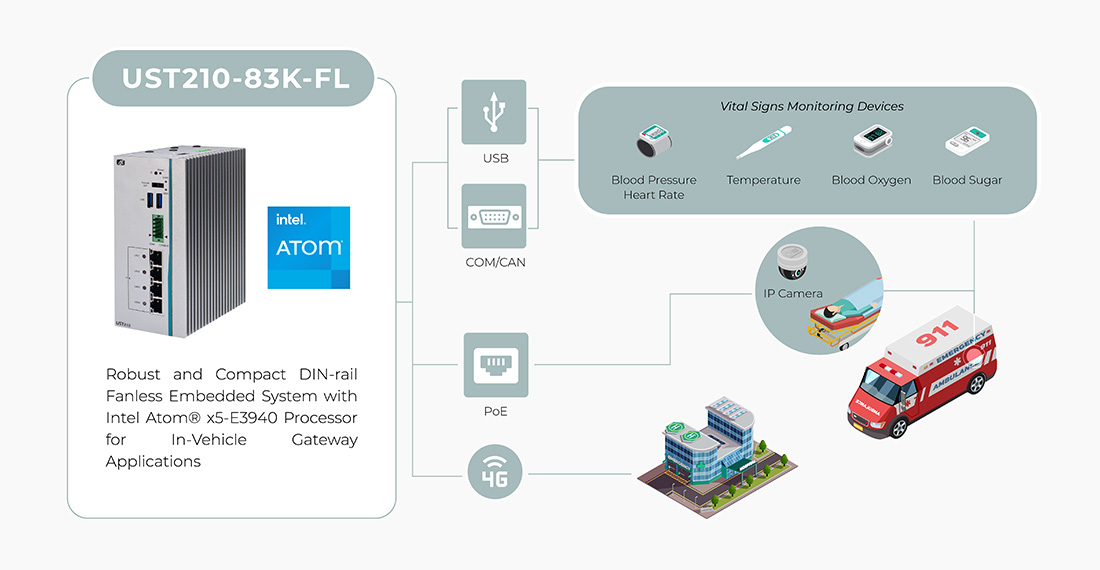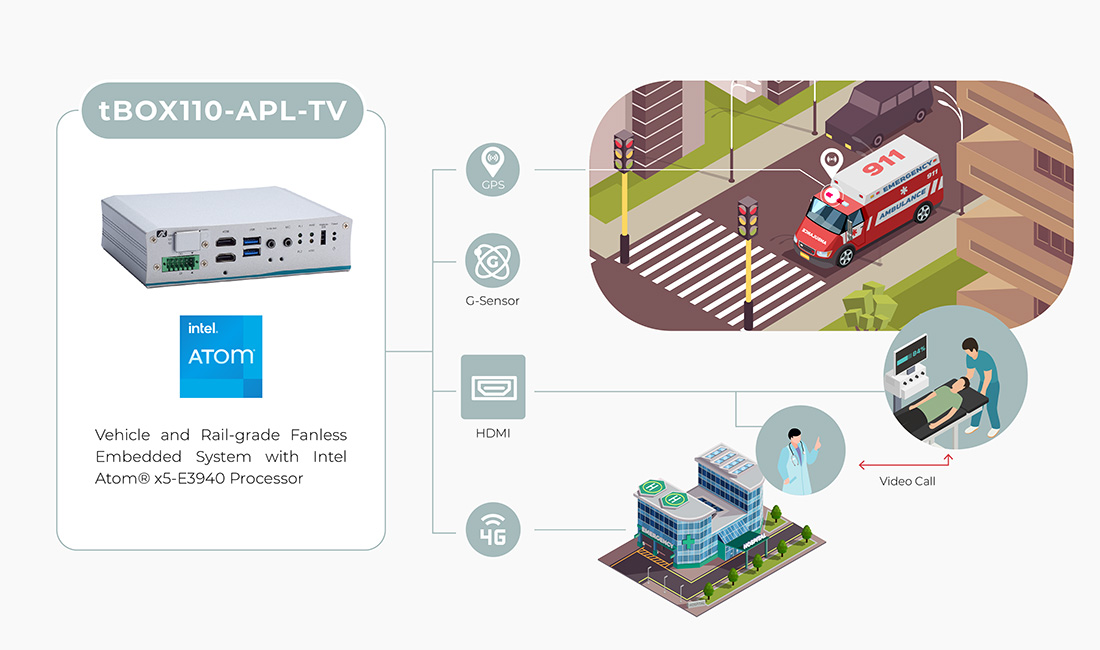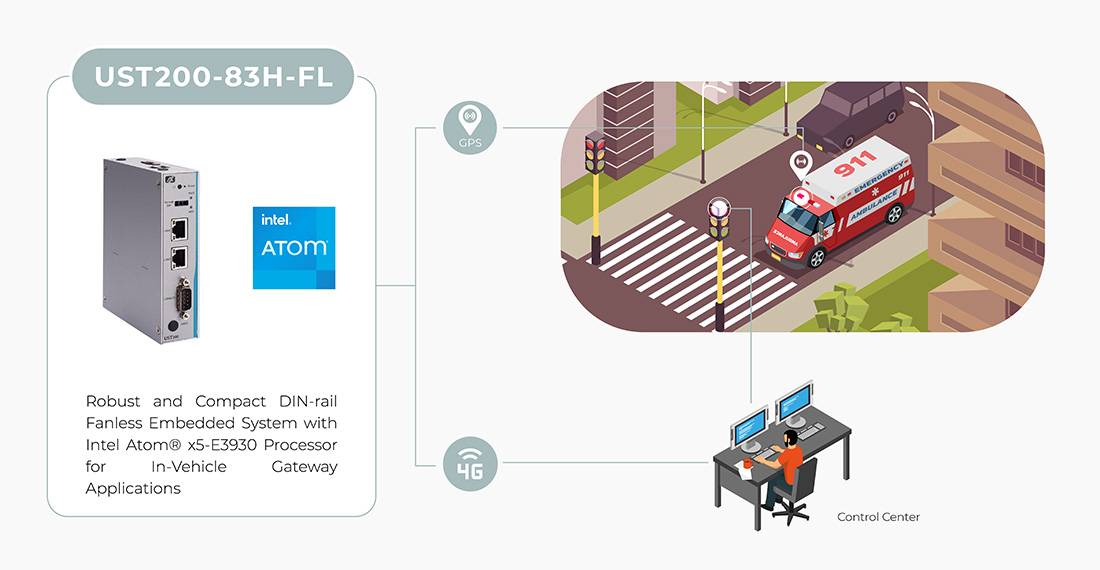The World Health Organization (WHO) reports that 27-58% of preventable prehospital trauma-related deaths result from delays in treatment and 50-76% stem from treatment errors. However, connected ambulances equipped with cutting-edge IoT technologies are revolutionizing emergency response by addressing these challenges. They enable real-time patient monitoring, seamless data and video transmission to emergency teams, and instant two-way communication with hospital specialists. Additionally, precise GPS-based live tracking enhances coordination between traffic control centers and hospitals, ensuring ambulances reach patients and medical facilities faster.
Axiomtek’s in-vehicle embedded systems offer compact, high-reliability, E-Mark-certified solutions, empowering connected ambulances with real-time data connectivity and robust wireless communication—helping save lives when every second counts.
Remote Treatment & Real-Time Vital Data Connectivity
The connected ambulance enables seamless, real-time transmission of vital signs, patient condition video feeds, and patient data to emergency room teams by integrating IoT-enabled medical devices. This connectivity allows physicians to assess the patient’s condition remotely, offer immediate treatment recommendations, and prepare for their arrival. These capabilities ensure faster, more informed treatment, bridging the gap between prehospital care and emergency room intervention.

UST210-83K-FL: E-Mark Certified Reliable In-Vehicle System with Seamless 4G Connectivity
4 x PoE and Rich I/O Interfaces
The UST210 (PoE version) enables real-time patient monitoring in ambulances with PoE-enabled LAN ports for IP camera integration, allowing hospitals to assess patient conditions via video remotely. Its rich I/O connectivity, including COM, USB, HDMI, and DIO, ensures seamless integration with medical devices, allowing hospitals to track patients’ vital signs in real-time.
Rugged & Reliable with E-Mark
The fanless UST210 is designed for in-vehicle use and has an E-Mark certification. It can withstand an extended operating temperature range of -40°C to +70°C and supports a wide power input of 12/24 VDC with Smart Ignition.
High-Speed 4G Connectivity for Continuous Monitoring
The UST210 features a full-size Mini Card slot for a 4G module, enabling fast, reliable wireless communication. Paramedics can transmit patient data and video consultations to hospitals, ensuring continuous monitoring and streamlined coordination for life-saving interventions.
Live Tracking and Two-Way Communication
Connected ambulances provide live location updates using GPS technology, allowing dispatch centers and hospitals to track their journey in real-time. This precise location data ensures timely rerouting when necessary and keeps medical teams prepared for incoming patients. Furthermore, a two-way communication channel enables clear, uninterrupted dialogue between EMTs, dispatchers, and emergency room staff. This reduces the risk of miscommunication and ensures that the ambulance crew receives critical updates on traffic, patient information, and medical advice as needed.

tBOX110-APL-TV: E-Mark Certified In-Vehicle Embedded System with Compact, Fanless, and Rugged Design
Real-Time Location Tracking with GPS
The tBOX110 ensures precise GPS-based live tracking, enabling dispatch centers and hospitals to monitor ambulance locations in real-time. This helps optimize routing, reduce delays, and ensure medical teams are ready for incoming patients.
Dual-Display Capability for Seamless Video Communication
The tBOX110 features dual HDMI ports, allowing smooth, real-time video communication between EMTs, dispatchers, doctors, and hospital staff. The feature ensures uninterrupted collaboration, with one screen dedicated to live video calls while the other simultaneously displays critical patient vital signs for immediate monitoring and decision-making.
Rugged Design with G-Sensor for Safety
Featuring a Mini PCIe expansion for the AX92160 G-sensor module, the tBOX110 can detect sudden acceleration, impacts, or harsh braking. This enhances fleet monitoring and provides valuable data for improving emergency driving safety.
Traffic Signal Preemption System
A key feature of the connected ambulance is its seamless integration with city traffic systems through a traffic signal preemption system. An advanced GPS/GNSS module enables the driver to determine the fastest route while continuously transmitting its real-time location to the hospital and the city’s traffic control center. Traffic operators can then adjust signals dynamically to ensure an uninterrupted route for the ambulance, reducing response times significantly.

UST200-83H-FL: E-Mark Certified In-Vehicle System with GPS and LTE Capability
GPS-Enabled Real-Time Traffic Signal Control
The UST200 integrates seamlessly with city traffic systems, utilizing its GPS module to provide precise, real-time ambulance location updates. This enables traffic control centers to dynamically adjust signals, creating a clear path for emergency vehicles.
E-Mark Certified & Meets MIL-STD-810G Standard
Designed for extreme environments, the UST200 features a fanless, cableless design with an extended operating temperature range of -40°C to +70°C and a 12/24 VDC power input with Smart Ignition support. Additionally, the rugged platform meets the rigorous MIL-STD-810G vibration standard (Method 514.6C-VI, Category 4), making it an ideal solution for in-vehicle applications.
Compact Yet Highly Expandable
Equipped with Mini PCIe slots, the ultra-lightweight and compact UST200 supports LTE and GPS modules, enhancing connectivity and positioning accuracy. Also, its GbE LAN and USB 2.0 ports enable stable and fast data exchange between the ambulance and traffic management systems, ensuring real-time updates for optimized route clearance.


